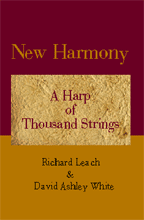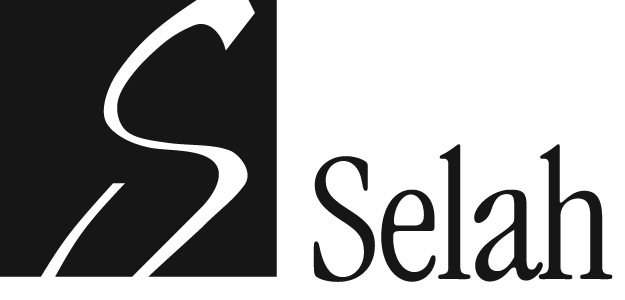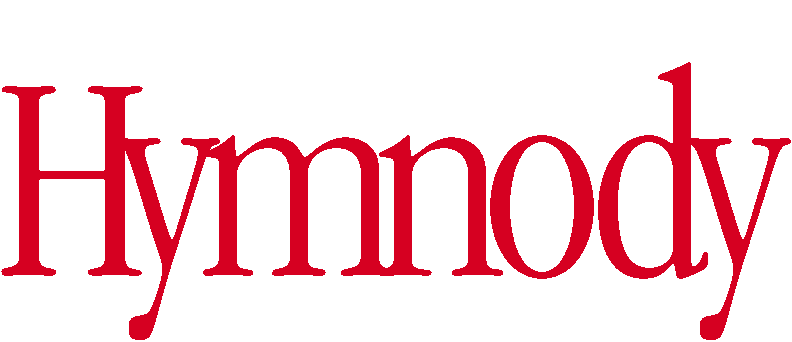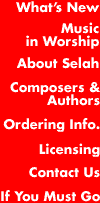New Harmony
A Harp of Thousand Strings
Hymn text collection
Author Richard Leach
Composer David Ashley White
Released July 2006
Catalog no. 125-427 (Soft-cover, spiral binding, 50 pp.)
Price $17.50 (U.S.)
Read the introductions by Richard Leach and David Ashley White, and composer notes by David Ashley White. Download an excerpt from this book.
Order now! 
 Order PDF download!
Order PDF download!


 Description Description
The folk hymnody of the American South, epitomized by The Sacred Harp and The Southern Harmony has inspired this collaboration by hymn poet Richard Leach and composer David Ashley White. The 28 selections provide singable new hymns for congregations, and effective anthems for choirs, throughout the church year. The hymns are arranged alphabetically by tune name; extensive indexes, author and composer introductions, and performance notes are included.
Introduction by Richard Leach
Our life contains a thousand springs,
and dies if one be gone;
strange that a harp of thousand strings
should keep in tune so long!
I came across that Isaac Watts stanza, on how fragile human life is, about ten years ago. I thought it was wonderful, and that the hymn it came from should be back in circulation. With that in mind, I made some small revisions to the text, and eventually wrote a new closing stanza. I had that hymn on hand when David Ashley White proposed that we work on a shape-note inspired collection together, and it has provided our subtitle.
The connection between Watts and shape-note hymnody is his popularity with shape-note composers and compilers. This collection’s "Oh, Were I Like a Feathered Dove" is another "collaboration" with Watts, half his words, half mine, paraphrasing Psalm 50. "The Bread We Break" borrows its last line from Watts. "The Angels Sing" adopts Watts's goal of making "David [the Psalmist] speak like a Christian"; it is a Christmas hymn based on Psalm 148.
Words by Charles Wesley ("Come On, My Partners in Distress") and the anonymous text and chorus writers of The Southern Harmony and The Sacred Harp are also here, along with wholly new texts. The themes of the collection span the church year, from Advent to Christmas, Ash Wednesday to Easter and Pentecost.
I greatly enjoyed working with David on this project. I had long wanted to do something of this scope with him and with his music. Some of the pieces began with his tunes, while others began with my words. Still others began with Sacred Harp tunes for which I wrote new words, followed by David arranging or adapting the old tune, in more timecrossing collaboration.
Our title, New Harmony, alludes to the many shape-note tune books with "harmony" in their titles, and is also the name of a tune within the collection, adapted by David from a Carolina folk song. Old hymns inspired this book, and David and I borrowed and stole from them as we wrote and composed. But everything here is a 21st century hymn. The old choruses, the Sacred Harp tunes, are not meant to show how hymns were done back then, for the interest of specialists; they are offered as a worthwhile way to do hymns now, for anyone and everyone who sings in Christian worship.
Now let my inward joys arise,
and burst into a song;
almighty love inspires my heart,
and pleasures tune my tongue.
The last line of that Isaac Watts stanza is here in adapted form in "The Bread We Break." May the work presented here enable pleasures from the shape-note hymn tradition to tune the tongues of singers today!
--Richard Leach
Advent, 2005, Lackawaxen, Pennsylvania
Introduction by David Ashley White
In New Harmony: A Harp of Thousand Strings, Richard Leach and I have made an admiring bow to Southern hymn collections from the 19th century, especially The Sacred Harp. Seven of the tunes, all original, come from my earlier collections and served as the genesis for the project. (In particular, WALES played an important role.) There are also new harmonizations of four Sacred Harp melodies, as well as two melody-in-the-tenor settings taken from Sacred Harp, transposed and in modern notation. Alan New employs the Sacred Harp tune, CHARLESTOWN, as a starting point for the creation of a new tune. NEW HARMONY uses an adapted Carolina folk song, and the remaining tunes that I composed are either influenced by folk music or, in various other ways, derived from the spirit of such music.
My interest in folk or folk-like melodies is not limited to hymn settings -- I've also used such material in my choral music and art songs, and even in a few instrumental works. Actually, music that is modal or employs gapped scales has long been a part of my general style, even before I knew that books such as The Sacred Harp existed. Explaining this interest is not difficult: compositions that I was exposed to early on had a lasting effect on my musical thinking -- for example, the Vaughan Williams Oboe Concerto that I performed as an undergraduate is laden with folk-like melodies. But perhaps a more important explanation is what I would call my musical DNA: my family background is rooted in the British Isles. Long before I was exposed to any musical influences that might have held their sway, I was already composing modal music, the same general kind that my blind great-grandfather, Fletcher Hurt Denson, played on his country fiddle in 19th- and early 20th-century rural Texas.
It was a genuine pleasure to work on this project with Richard, whose sacred poetry I hold in high esteem. Our collaboration on New Harmony began with general discussions about procedure and overall concept, and continued as we dealt with specific issues of words and music. From time to time, we were able to reconsider or rethink our plans in a way that allowed for a healthy amount of give and take. I enjoyed this process as much as I did the actual composing.
Our goal was to present texts and music that would honor an important part of our literary and musical heritage as well as enrich today's worship by mixing past with present. We are pleased to share the results with you.
--David Ashley White
Advent, 2005, Houston, Texas
Composer's notes by David Ashley White
In keeping with the editorial policy found in various hymnals and other collections, we have not used meter signatures in New Harmony: A Harp of Thousand Strings. In most cases, the hymn tunes conform to a single meter, and when they do not, the basic pulse remains the same throughout. Exceptions are the three settings listed in the third paragraph below.
As an aid to singing these hymns, I have included a metronome marking for each, as well as a descriptive word or two that pertains to general style or intent. Please note that in most of the tunes that contain four quarters per measure, the pulse is the half note.
While the music found in this collection is generally intended for congregational singing, some could also be used to create anthems. Five of the tunes include descants that could embellish a congregational hymn or provide textural variety for choral use. Further anthem material could come from the pairing of an original Sacred Harp setting (BOUND FOR CANAAN or A SONG OF TEXAS, both included in modern notation), with my harmonization/adaptation of these tunes. NEW ORLEANS NEW is an original tune that is presented in a modern Sacred Harp style, with the melody in the tenor, as well as in four parts with the melody in the soprano. The typical practice for singing Sacred Harp settings is for each harmonic part, except the bass, to be sung by both men and women.
Two tunes vary a bit from the "norm," and could easily be performed chorally: CANAL STREET, which is two-parts and could be sung a cappella or with bells, and the unison NEW HARMONY, which features an independent keyboard part more akin to a song accompaniment.
Two tunes, BLUE PLANET and WALES, both containing alternating sections (ABA and AABBABA, respectively), are designed as choral works and/or for congregational singing. (They are used in both ways in my home parish, Palmer Church.)
Several of the tune names in this book come from New Orleans (in addition to CANAL STREET and NEW ORLEANS NEW, there are COBALT and GARDEN DISTRICT). All were composed during or immediately after Hurricane Katrina. When I paid a brief visit to New Orleans two months ago, I found Cobalt, the restaurant in the Hotel Monaco, still closed. But Canal Street and the Garden District were well on their way towards recovery. We all hope that New Orleans will indeed again be New.
---D.A.W., May 2006
|




